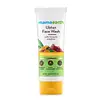What's inside
What's inside
 Key Ingredients
Key Ingredients

 Benefits
Benefits

 Concerns
Concerns

 Ingredients Side-by-side
Ingredients Side-by-side

Water
Skin ConditioningNiacinamide
SmoothingButylene Glycol
HumectantTrehalose
HumectantPhenoxyethanol
PreservativeGlycerin
HumectantGlyceryl Glucoside
HumectantMaris Aqua
HumectantGlycine Soja Seed Extract
Skin ConditioningGlycine Soja Extract
Skin ConditioningPotassium Sorbate
PreservativeCitric Acid
BufferingSaccharide Isomerate
HumectantSodium Citrate
BufferingSilica
AbrasiveOryza Sativa Extract
AbsorbentSodium Polyacrylate Starch
AbsorbentSodium Hyaluronate
HumectantDisodium EDTA
Aphanothece Sacrum Polysaccharide
AbsorbentWater, Niacinamide, Butylene Glycol, Trehalose, Phenoxyethanol, Glycerin, Glyceryl Glucoside, Maris Aqua, Glycine Soja Seed Extract, Glycine Soja Extract, Potassium Sorbate, Citric Acid, Saccharide Isomerate, Sodium Citrate, Silica, Oryza Sativa Extract, Sodium Polyacrylate Starch, Sodium Hyaluronate, Disodium EDTA, Aphanothece Sacrum Polysaccharide
Water
Skin ConditioningStearic Acid
CleansingSodium Cocoyl Glycinate
CleansingGlycerin
HumectantPalmitic Acid
EmollientCocos Nucifera Oil
MaskingJuglans Regia Seed
AbrasiveCrocus Sativus Flower Extract
MaskingNiacinamide
SmoothingDaucus Carota Sativa Seed Oil
EmollientTocopheryl Acetate
AntioxidantCurcuma Longa Root Powder
Skin ConditioningDipotassium Glycyrrhizate
HumectantOrange Roughy Oil
Skin ConditioningCananga Odorata Flower Oil
MaskingPogostemon Cablin Leaf Oil
MaskingWater, Stearic Acid, Sodium Cocoyl Glycinate, Glycerin, Palmitic Acid, Cocos Nucifera Oil, Juglans Regia Seed, Crocus Sativus Flower Extract, Niacinamide, Daucus Carota Sativa Seed Oil, Tocopheryl Acetate, Curcuma Longa Root Powder, Dipotassium Glycyrrhizate, Orange Roughy Oil, Cananga Odorata Flower Oil, Pogostemon Cablin Leaf Oil
 Reviews
Reviews

Ingredients Explained
These ingredients are found in both products.
Ingredients higher up in an ingredient list are typically present in a larger amount.
Glycerin is already naturally found in your skin. It helps moisturize and protect your skin.
A study from 2016 found glycerin to be more effective as a humectant than AHAs and hyaluronic acid.
As a humectant, it helps the skin stay hydrated by pulling moisture to your skin. The low molecular weight of glycerin allows it to pull moisture into the deeper layers of your skin.
Hydrated skin improves your skin barrier; Your skin barrier helps protect against irritants and bacteria.
Glycerin has also been found to have antimicrobial and antiviral properties. Due to these properties, glycerin is often used in wound and burn treatments.
In cosmetics, glycerin is usually derived from plants such as soybean or palm. However, it can also be sourced from animals, such as tallow or animal fat.
This ingredient is organic, colorless, odorless, and non-toxic.
Glycerin is the name for this ingredient in American English. British English uses Glycerol/Glycerine.
Learn more about GlycerinNiacinamide is a multitasking form of vitamin B3 that strengthens the skin barrier, reduces pores and dark spots, regulates oil, and improves signs of aging.
And the best part? It's gentle and well-tolerated by most skin types, including sensitive and reactive skin.
You might have heard of "niacin flush", or the reddening of skin that causes itchiness. Niacinamide has not been found to cause this.
In very rare cases, some individuals may not be able to tolerate niacinamide at all or experience an allergic reaction to it.
If you are experiencing flaking, irritation, and dryness with this ingredient, be sure to double check all your products as this ingredient can be found in all categories of skincare.
When incorporating niacinamide into your routine, look out for concentration amounts. Typically, 5% niacinamide provides benefits such as fading dark spots. However, if you have sensitive skin, it is better to begin with a smaller concentration.
When you apply niacinamide to your skin, your body converts it into nicotinamide adenine dinucleotide (NAD). NAD is an essential coenzyme that is already found in your cells as "fuel" and powers countless biological processes.
In your skin, NAD helps repair cell damage, produce new healthy cells, support collagen production, strengthen the skin barrier, and fight environmental stressors (like UV and pollution).
Our natural NAD levels start to decline with age, leading to slower skin repair, visible aging, and a weaker skin barrier. By providing your skin niacinamide, you're recharging your skin's NAD levels. This leads to stronger, healthier, and younger looking skin.
Another name for vitamin B3 is nicotinamide. This vitamin is water-soluble and our bodies don't store it. We obtain Vitamin B3 from either food or skincare. Meat, fish, wheat, yeast, and leafy greens contain vitamin B3.
The type of niacinamide used in skincare is synthetically created.
Learn more about NiacinamideWater. It's the most common cosmetic ingredient of all. You'll usually see it at the top of ingredient lists, meaning that it makes up the largest part of the product.
So why is it so popular? Water most often acts as a solvent - this means that it helps dissolve other ingredients into the formulation.
You'll also recognize water as that liquid we all need to stay alive. If you see this, drink a glass of water. Stay hydrated!
Learn more about Water